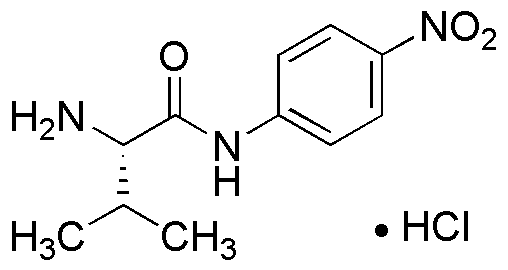L-Valine 4-nitroanilide hydrochloride is widely utilized in research focused on:
- Biochemical Assays: This compound serves as a substrate in enzyme assays, particularly for proteases, enabling researchers to study enzyme kinetics and activity.
- Drug Development: It plays a role in the synthesis of pharmaceutical intermediates, aiding in the development of new drugs with improved efficacy and reduced side effects.
- Protein Engineering: Used in the modification of peptides and proteins, it helps scientists design more effective therapeutic proteins for various diseases.
- Analytical Chemistry: This chemical is employed in chromatography as a derivatizing agent, enhancing the detection of amino acids and other biomolecules.
- Research on Nitric Oxide Synthase: It is utilized in studies related to nitric oxide synthase, contributing to the understanding of cardiovascular health and related disorders.
General Information
Properties
Safety and Regulations
Applications
L-Valine 4-nitroanilide hydrochloride is widely utilized in research focused on:
- Biochemical Assays: This compound serves as a substrate in enzyme assays, particularly for proteases, enabling researchers to study enzyme kinetics and activity.
- Drug Development: It plays a role in the synthesis of pharmaceutical intermediates, aiding in the development of new drugs with improved efficacy and reduced side effects.
- Protein Engineering: Used in the modification of peptides and proteins, it helps scientists design more effective therapeutic proteins for various diseases.
- Analytical Chemistry: This chemical is employed in chromatography as a derivatizing agent, enhancing the detection of amino acids and other biomolecules.
- Research on Nitric Oxide Synthase: It is utilized in studies related to nitric oxide synthase, contributing to the understanding of cardiovascular health and related disorders.
Documents
Safety Data Sheets (SDS)
The SDS provides comprehensive safety information on handling, storage, and disposal of the product.
Product Specification (PS)
The PS provides a comprehensive breakdown of the product’s properties, including chemical composition, physical state, purity, and storage requirements. It also details acceptable quality ranges and the product's intended applications.
Certificates of Analysis (COA)
Search for Certificates of Analysis (COA) by entering the products Lot Number. Lot and Batch Numbers can be found on a product’s label following the words ‘Lot’ or ‘Batch’.
Numéro de catalogue
Numéro de lot/série
Certificates Of Origin (COO)
This COO confirms the country where the product was manufactured, and also details the materials and components used in it and whether it is derived from natural, synthetic, or other specific sources. This certificate may be required for customs, trade, and regulatory compliance.
Numéro de catalogue
Numéro de lot/série
Safety Data Sheets (SDS)
The SDS provides comprehensive safety information on handling, storage, and disposal of the product.
DownloadProduct Specification (PS)
The PS provides a comprehensive breakdown of the product’s properties, including chemical composition, physical state, purity, and storage requirements. It also details acceptable quality ranges and the product's intended applications.
DownloadCertificates of Analysis (COA)
Search for Certificates of Analysis (COA) by entering the products Lot Number. Lot and Batch Numbers can be found on a product’s label following the words ‘Lot’ or ‘Batch’.
Numéro de catalogue
Numéro de lot/série
Certificates Of Origin (COO)
This COO confirms the country where the product was manufactured, and also details the materials and components used in it and whether it is derived from natural, synthetic, or other specific sources. This certificate may be required for customs, trade, and regulatory compliance.


